Shoebill Profile
The shoebill is a large, elusive, stalk-like bird with an almost prehistoric appearance, due to its oversized shoe-shaped beak. They are sometimes referred to as ‘whalehead‘.
Shoebills are found in East Africa’s freshwater swamps and marshes, including Uganda, Sudan, the eastern Democratic Republic of the Congo, Zambia, Kenya, Ethiopia, Botswana, and Tanzania. Its distribution is frequently associated with the presence of papyrus vegetation and lungfish.
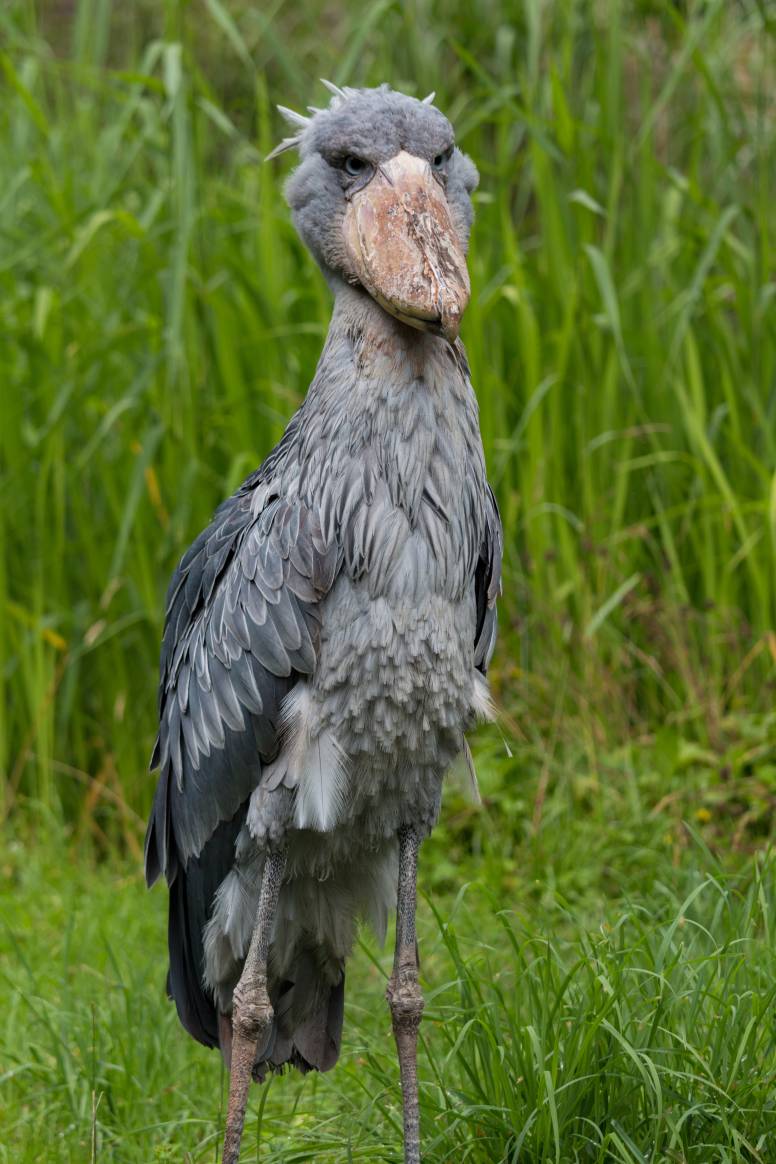
Shoebill Facts Overview
| Habitat: | Swamps & marshlands |
| Location: | East Africa – Uganda, Sudan, eastern Democratic Republic of the Congo, Zambia, Kenya, Ethiopia, Botswana and Tanzania. |
| Lifespan: | 35 Years |
| Size: | 3.5 – 4.5 ft (1 – 1.4m) |
| Weight: | 9 – 15.5 lbs (4 – 7 kg) |
| Color: | Grey |
| Diet: | Mainly fish. Occasionally frogs, snakes, snails, rodents & even baby crocodiles |
| Predators: | Humans, Crocodiles |
| Top Speed: | 35-48 kph (20 – 30 mph) |
| Conservation Status: |
Vulnerable |
Shoebill were previously thought of as storks, but genetic research has re-classified them as members of the order Pelecaniformes and family Balaenicipitidae, which are large waterbirds, genetically closer to pelicans and herons.
The shoebill is piscivorous, primarily eating fish – in particular lungfish, as well as bichirs, tilapia and catfish. However, it does occasionally hunt and eat other prey, such as frogs, lizards, watersnakes, snails and rodents.
The shoebill is an extremely tall bird, with long spindly legs, that allows it to stand in the shallows of swamps and on aquatic vegetation, while hunting for food. The shoebill averages between 3.5 – 4.5 feet (1 – 1.4 meters) in height, and weighs between 9 – 15.5 pounds (4 – 7 kg). It has broad wings, with an average wingspan between 7.5 – 8.5 feet (2.2 – 2.6m).
The shoebill population is particularly difficult to evaluate with accuracy, due to where they habitat and their elusive nature, but it has declined – with estimates between 5,000 – 8,000 in total.
BirdLife International has classified it as vulnerable, due to habitat destruction, disturbance and hunting. Shoebill have specific habitat requirements for breeding, nesting and hunting, and their swamps and marshes are gradually being transformed into agricultural land, or pastures for cattle grazing.
Interesting Shoebill Facts
1. They have a prehistoric-like appearance
At times, and from certain angles, they can appear rather menacing, peering down their long, razor sharp beak, with a hook at the tip.
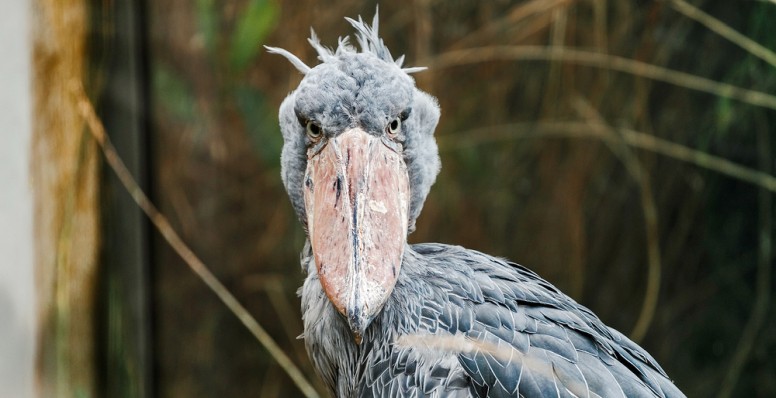
They can also be extremely cute, and almost ‘cartoon-like’. They have striking pale, blue-eyed genes, which can make them appear not really real.
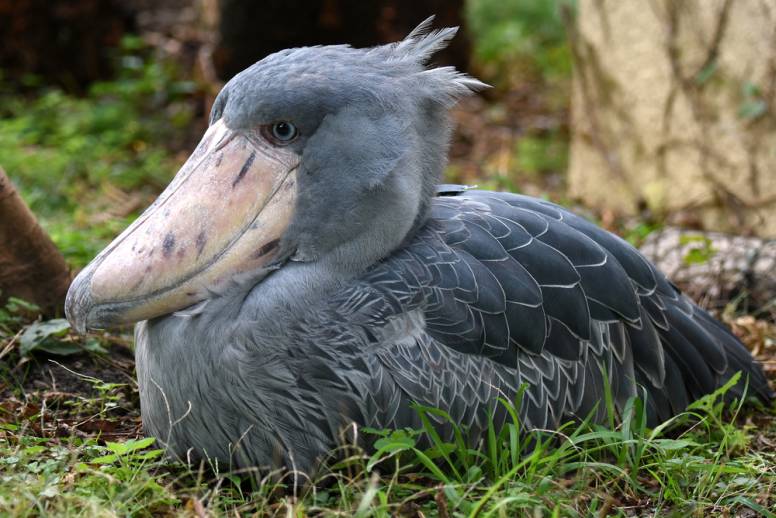
They are truly unique and beautiful birds.
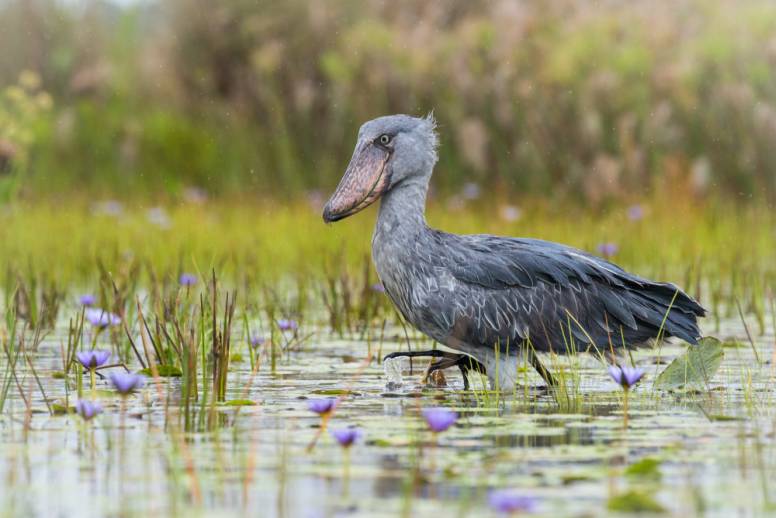
2. The shoebill’s flapping when flying is one of the slowest of any birds, at a mere (approx.) 150 flaps per minute
Only larger stalk species have slower flapping than the shoebill.

3. They have the 3rd longest beak in the world, which enables them to hunt extremely large prey, even baby crocodiles
Their beaks can reach up to 24cm in length and 20cm (7.4 to 9.4 inches) in width, which helps them hunt for fish or snakes as long as 3.2 feet (1m) in size.
4. The razor sharp edges of it’s beak, allow it to decapitate their prey quickly
They are known to often behead their prey, before consuming whole.1

5. A shoebill can often benefit from the presence of hippos, which disturb fish, and bulldoze paths through swamps
The shoebill can take advantage of the disturbed fish in the water and strike.
6. The shoebill is an ambush predator
They often stands still for long periods, motionless like a statue, before launching a vicious attack to kill any prey that come within strike distance.
The shoebill often feeds at night, and is also known to stand on floating vegetation to hunt their prey.
7. The shoebill favours areas of poorly oxygenated water
This causes the fish living in the water to surface for air more often, which increases the liklihood of the shoebill striking and capturing its prey.
8. They clatter their bills which like a machine gun
The shoebill is usually silent, but they are known to clatter their bills loudly during courtship or greeting, which can sound a little like a machine gun.
Bill-clattering is a behaviour of real storks. They can also let out a high pitched whine, and even make cow-like ‘moo’ noises.
9. Shoebill are solitary in their breeding habits, with typically less than 3 nests per square kilometer
The nesting shoebill will vigorously defend their territory between 2 – 4 square kilometers (1 to 1.5 square miles) from other shoebill, and large birds.
10. Shoebills chicks often bully, fight and can kill their siblings (known as ‘siblicide’) when only a few weeks old
Rather disturbingly, this is actually rather common in larger birds.
Often the older, and bigger chick, can hurt a smaller chick, while their parents are away from the nest eventually driving it to live away from the nest. Research suggests, this is due to energy efficiency and survival of the fittest. 2
11. The shoebill female always lays two eggs, but only one ever survives
The second egg is seen like a ‘back up’, in case anything is wrong with the first egg. Usually the first to hatch survives only. 3
12. The shoebill has long fascinated civilizations
They appear in wall paintings and hieroglyphics of ancient Egyptians, and it’s old Arabic name is Abu-markub, or ‘Father of a Slipper’. This name is in reference to the birds very distinctive beak.

13. Sadly, the demand for shoebill storks is high
Both in zoos, or for private collectors. There are reports that they can sell for US $10,000-$20,000, making them the most expensive birds in the zoo trade.
The high price encourages shady traders to capture the shoebill and sell to zoos or middle men – reducing the wild population size further. Shoebills rarely breed in captivity. 4
14. They are incredibly rare
Birding enthusiasts have to pay local expert guides to go on specialist shoebill tours and safaris, to try and get a glimpse of the elusive, sought after birds in the wild.
This involves going way off the beaten track and into the swamps which they inhabit.
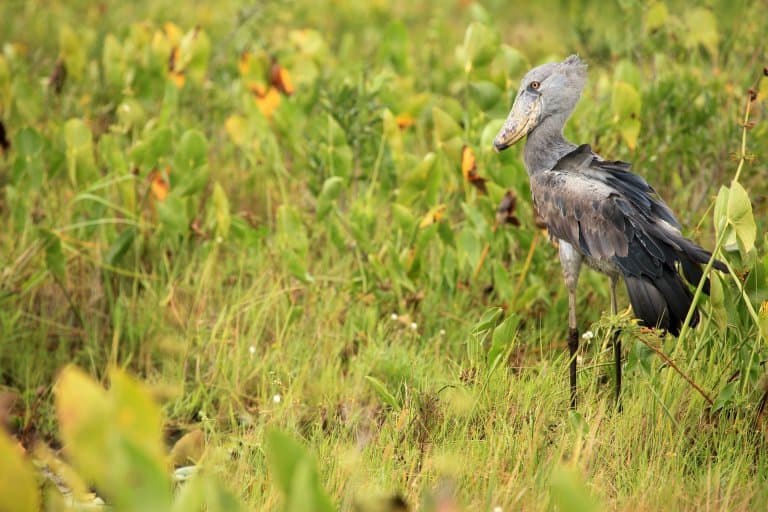
Shoebill Fact-File Summary
Scientific Classification
| Kingdom: | Animalia |
| Phylum: | Chordata |
| Class: | Aves |
| Order: | Pelecaniformes |
| Family: | Balaenicipitidae |
| Species Name: |
Balaeniceps Rex |
Fact Sources & References
- R. Pope (2016). “5 Facts You Didn’t Know About Africa’s Shoebill”, via Zambia Tourism.
- 2013, “Monster Bird Reveals Dark Side”, via BBC Nature.
- 2013, “Monster Bird Reveals Dark Side”, via BBC Nature.
- A. Steffen, “Balaeniceps rexshoebill”, via Animal Diversity.
